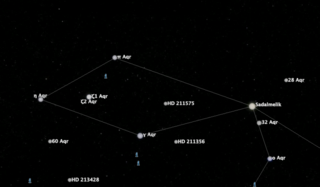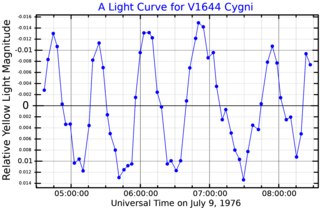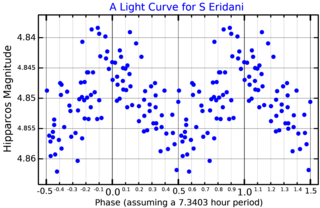Psi Scorpii, which is Latinized from ψ Scorpii, is a star in the zodiac constellation of Scorpius. It is white in hue and has an apparent visual magnitude of 4.94, which is bright enough to be faintly visible to the naked eye. Based upon parallax measurements, it is located at a distance of around 162 light years from the Sun. Data collected during the Hipparcos mission suggests it is an astrometric binary, although nothing is known about the companion. The system is drifting closer to the Sun with a radial velocity of −5 km/s.
15 Andromedae, abbreviated 15 And, is a single, variable star in the northern constellation of Andromeda. 15 Andromedae is the Flamsteed designation, while its variable star designation is V340 And. Its apparent visual magnitude is 5.55, which indicates it is faintly visible to the naked eye. Its estimated distance from the Earth is 252 light years, and it is moving further away with a heliocentric radial velocity of 13 km/s.
Xi Aurigae, Latinized from ξ Aurigae, is the Bayer designation for a single, white-hued star in the northern constellation of Auriga. This star was once considered part of the constellation of Camelopardalis and held the Flamsteed designation 32 Camelopardalis. It is visible to the naked eye with an apparent visual magnitude of +5.0. The measured annual parallax shift of this star is 13.69 ± 0.28 mas, which corresponds to a physical distance of 238 light-years with a 5 light-year margin of error. At that distance, the visual magnitude of the star is diminished by an extinction of 0.108 due to interstellar dust.
Chi Boötis, Latinised as χ Boötis, is a single, white-hued star in the northern constellation Boötes, near the eastern constellation border with Corona Borealis. It is faintly visible to the naked eye with an apparent visual magnitude of +5.3. Based upon an annual parallax shift of 13.0 mas as seen from the Earth, it is located about 251 light-years from the Sun. The star is moving closer to the Sun with a radial velocity of −16 km/s.
33 Boötis is a single star in the northern constellation Boötes, located 188 light years away from the Sun. It is visible to the naked eye as a faint, white-hued star with an apparent visual magnitude of 5.39. The object is moving closer to the Earth with a heliocentric radial velocity of −13 km/s, and is catalogued as a member of the Pleiades supercluster.
40 Boötis is a single star located 166.5 light years away from the Sun in the northern constellation of Boötes. It is visible to the naked eye as a dim, yellow-white hued star with an apparent visual magnitude of 5.64. The star is moving away from the Earth with a heliocentric radial velocity of +12 km/s.
HD 5789 and HD 5788 is a pair of stars comprising a binary star system in the northern constellation of Andromeda. Located approximately 151 parsecs (490 ly) away, the primary is a hot, massive blue star with an apparent magnitude of 6.06 while the secondary is slightly smaller and cooler, with an apparent magnitude of 6.76. Both stars are main-sequence stars, meaning that they are currently fusing hydrogen into helium in their cores. As of 2016, the pair had an angular separation of 7.90″ along a position angle of 195°. While both have a similar proper motion and parallax, there's still no proof that the pair is gravitationally bound.
HD 225218 is a quadruple star system in the northern constellation of Andromeda. The primary component, HD 225218 A, is a giant star with a stellar classification of B9III, an apparent magnitude of 6.16, and is a candidate Lambda Boötis star. It has a fainter, magnitude 9.65 companion, HD 225218 B, at an angular separation of 5.2″ along a position angle of 171°. The primary itself has been identified as a binary star system through interferometry, with the two components separated by 0.165″. The pair, HD 225218 Aa and Ab, orbit each other with a period of about 70 years and an eccentricity of 0.515. Component B is likewise a spectroscopic binary.
HD 179791 is suspected variable star in the equatorial constellation of Aquila. It is a challenge to see with the naked eye even under good viewing conditions, having an apparent visual magnitude of 6.48. The distance to HD 179791 can be estimated from its annual parallax shift of 5.3 mas, which yields a value of 616 light years. It is moving further from the Earth with a heliocentric radial velocity of +16 km/s. Astrometric measurements of the star show changes in motion that may indicate it is a member of a close binary system.
Tau2 Serpentis, Latinized from τ2 Serpentis, is a star in the constellation of Serpens, located approximately 480 light-years from the Sun. It is a challenge to view with the naked eye, having an apparent visual magnitude of 6.22. The star is drifting closer with a radial velocity of −19 km/s.
HD 3 is a single, white-hued star in the northern constellation Andromeda. With an apparent visual magnitude of 6.71, it is below the nominal brightness limit for visibility with the typical naked eye but may still be visible by some observers under ideal viewing conditions. Based upon an annual parallax shift of 6.3137±0.0826 mas, it is located roughly 517 light years away. The star is moving closer with a heliocentric radial velocity of −18 km/s, and will make perihelion in around 2.9 million years at a separation of around 351 ly (107.71 pc).

Epsilon Herculis, Latinized from ε Herculis, is a fourth-magnitude multiple star system in the northern constellation of Hercules. The combined apparent visual magnitude of 3.9111 is bright enough to make this system visible to the naked eye. Based upon an annual parallax shift of 21.04 mas as seen from Earth, it is located 155 light years from the Sun. The system is moving closer to the Sun with a radial velocity of −25 km/s.

HD 211575 is a star in the constellation Aquarius in between "Gamma Aquarii", "Pi Aquarii" and "Sadalmelik". It is a member of the corona of the Ursa Major moving group.

29 Cygni is a single star in the northern constellation of Cygnus. It is dimly visible to the naked eye as a white-hued star with an apparent visual magnitude of 4.93. The distance to 29 Cyg, as estimated from an annual parallax shift of 24.9 mas, is 131 light years. The star is moving closer to the Earth with a heliocentric radial velocity of −17 km/s. It is a member of the 30–50 million year old Argus Association of co-moving stars.
HD 16754 is a binary or triple-star system in the constellation Eridanus. It has the Bayer designation s Eridani; HD 16754 is the designation from the Henry Draper catalogue. The system is visible to the naked eye as a faint point of light with an apparent visual magnitude of +4.74. It is located at a distance of approximately 132 light years from the Sun based on parallax, and is drifting further away with a radial velocity of +18 km/s. The system is a member of the Columba association of co-moving stars.

64 Eridani is a single, yellow-white hued star in the constellation Eridanus having variable star designation S Eridani. It is faintly visible to the naked eye with an apparent visual magnitude of 4.77. The annual parallax shift is measured at 12.01 mas, which equates to a distance of about 272 light years. In addition to its proper motion, it is moving closer to the Sun with a radial velocity of around −9 km/s.
HD 125442 is a single star in the southern constellation of Lupus. Its apparent visual magnitude is 4.78, which can be seen with the naked eye. The distance to HD 125442, as determined from its annual parallax shift of 22.1 mas, is 147 light years.
36 Serpentis is a binary star system in the equatorial constellation of Serpens. It has the Bayer designation b Serpentis, while 36 Serpentis is the Flamsteed designation. The system is visible to the naked eye as a dim, white-hued point of light with a combined apparent visual magnitude of 5.09. It is located 162 light years away from the Sun based on parallax, and is moving closer with a radial velocity of −8 km/s.
HD 26764 is a solitary star located in the northern circumpolar constellation Camelopardalis. It has an apparent magnitude of 5.19, making it faintly to the naked eye if seen under ideal conditions. The star is currently situated at a distance of 266 light years but is drifting closer with a heliocentric radial velocity of 3.0 km/s, which is poorly constrained.
HD 218108, also known as HR 8786, is a solitary, white hued star located in the southern circumpolar constellation Octans. It has an apparent magnitude of 6.11, making it faintly visible to the naked eye under ideal conditions. Based on parallax measurements from Gaia DR3, the object is estimated to be 247 light years away. It appears to be approaching the Solar System with a fairly constrained radial velocity of −7 km/s. Paunzen et al. (2001) lists it as a λ Boötis star with a weak magnesium line.




